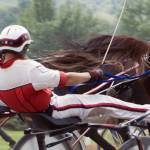Training Horses for Speed or Endurance

Simply stated, the goal of a training or physical conditioning program is to enhance a horse’s ability to perform better and more easily. Therefore, by the end of several months of training, the racehorse will be able to run faster and recover more quickly after exercise. The trail horse will climb hills more easily, the dressage horse will gain strength and flexibility, and the reiner will be able to do more spins and sliding stops before fatigue sets in.
A training schedule begins with short periods of easy work and progresses gradually into longer sessions of more demanding exercise. Training should be planned over several months and the rider should be careful not to progress too quickly. Asking for an effort the horse is not ready to produce is likely to cause injury and set the training program back instead of moving it smoothly forward. As the training sessions become longer, the horse’s skeletal system, connective tissues (tendons
and ligaments), respiratory system, circulatory system, and muscular system will all react to the increased demands of harder exercise. One of the most obvious changes will be in the horse’s appearance as its muscles increase in size and become more defined through regular exercise.
Horses, like other mammals, have several types of muscle fibers. Type 1 (slow-twitch) fibers contract slowly and are able to hold this contraction for a relatively long time without fatigue. They are used mostly in low-intensity exercise such as endurance riding. Type 1 fibers have a high density of mitochondria, conferring a high aerobic or oxidative capacity. They also have the highest oxidative capacity, fat stores, and capillary density as well as the lowest glycogen stores and glycolytic enzyme capacity. Fast-twitch (type 2) muscle fibers are divided into type 2A and 2B fibers. Type 2B fibers have the fastest contractile speed, the largest cross-sectional area, the highest glycogen stores and glycolytic capacity, and the lowest oxidative capacity. They are ideally suited to short, fast bursts of power such as jumping or sprint racing. Type 2A fibers are intermediate in contractile speed and metabolic properties between type 1 and type 2B fibers.
Each horse has all three types of muscle fibers, but the proportions of each type will vary from breed to breed, and from horse to horse within each breed. It is this variation that makes some horses more suitable for one type of exercise than another. If all other factors are equal, a horse with a larger proportion of fast-twitch muscle fibers will perform better in short-duration, high-intensity exercise, while a horse with a larger proportion of slow-twitch fibers will excel in an activity that calls for long-duration, low-intensity exercise. A training program can increase both speed and endurance, but the horse will probably still excel in one exercise type or the other because of the way his muscle fibers are proportioned.
Endurance training in horses changes the contractile and metabolic profile of skeletal muscles. They become more efficient at using energy, especially from fat. After a short period of training, the volume density of mitochondria, and thus the oxidative enzyme capacity, all increase. Over a six-month period the ratio of type 2A to type 2B fibers increases and the cross-sectional area of type 2B muscle fibers decreases. Additional capillaries are formed to increase blood flow to all muscle fibers. These adaptations favor the delivery of oxygen and blood-borne energy sources, the early activation of oxidative metabolism, and the utilization of free fatty acids (FFA) in muscle fibers. As the muscles begin to derive more energy from fat and less from muscle glycogen, endurance is enhanced and fatigue is delayed.
Sprinters, jumpers, and barrel horses are trained less for endurance and more for fast, explosive, powerful action. As an effect of high-intensity training, the horse will gradually delay the onset of lactate accumulation and ATP depletion. This is accomplished by an increase in the oxidative capacity (by increased mitochondrial volume) and better capillarization of all muscle fiber types, including type 2B fibers.
Training of two- and three-year-old Standardbred and Thoroughbred racehorses in Scandinavia had been shown to reduce the percentage of type 2B fibers and increase the percentage of type 2A fibers as well as decrease the cross-sectional area of type 2B fibers. Although an increase in oxidative capacity may be metabolically advantageous, a decrease in the percentage of type 2B fibers and a decrease in their cross-sectional areas may also deleteriously affect their speed and force of contraction. Muscle must have the ability to generate energy via anaerobic glycolysis for racehorses to be successful. Obviously, a balance is required between skeletal muscle fiber metabolic and contractile properties for optimum speed and endurance. Because the muscle fiber composition and fiber properties vary so greatly between horses, achievement of this balance may be different for each horse.








